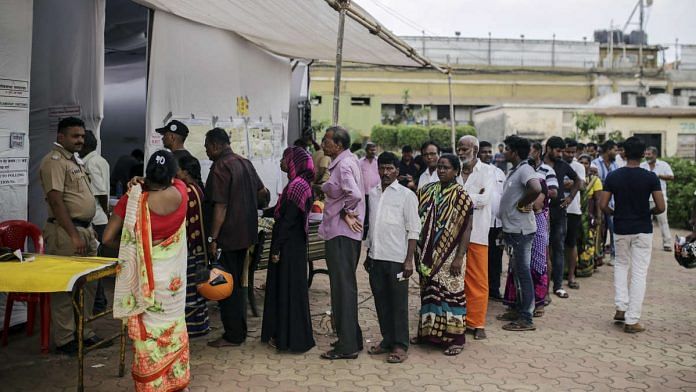Mumbai: Mumbai has always been criticised for its tepid voter turnout, but there is one part of the city that has taken the bulk of the flak for its voter lethargy — the plush Mumbai South constituency.
But, over the past few years, as the city has grown and affluence has spread, another part of the Mumbai has also become infamous for its voter apathy — Bandra and its neighbouring suburbs, which fall under the Mumbai North Central parliamentary seat.
The constituency comprises the Assembly segments of Bandra West, Bandra East, Kalina, Kurla, Chandivali and Vile Parle. Mumbai voted Monday, in the fourth phase of the Lok Sabha elections.
The turnout in the Mumbai North Central seat was 53.64 per cent, the second lowest after Mumbai South’s 51.45 per cent.
The average voter turnout of all the six constituencies in Mumbai was 55.28 per cent, according to official data.
Mumbai North Central as lethargic as Mumbai South
In Monday’s election, Chandivali had the lowest voting percentage at 50.79 per cent. The turnout in Kurla, Bandra West and Bandra East was 51.29 per cent, 52.45 per cent, and 52.74 per cent, respectively. The overall average of Mumbai North Central was boosted by the Vile Parle Assembly segment, which recorded a robust 61.19 per cent turnout.
In Mumbai South, the most elite areas such as Colaba and Malabar Hill have always clocked poor voter turnout. On Monday, while Colaba’s turnout was 45.16 per cent, turnout in Malabar Hill was higher than the city’s average at 56.08 per cent.
In previous elections too, Mumbai North Central, the home constituency of Shiv Sena chief Uddhav Thackeray’s family, has clocked voting percentages as poor or even worse than Mumbai South.
In the 2009 Lok Sabha elections, the voter turnout in Mumbai North Central was 39.5 per cent against Mumbai South’s 40.3 per cent and the city’s average of 41.38 per cent.
In the 2014 elections, when the city’s turnout jumped amid a visible ‘Modi wave’, the turnout in Mumbai North Central was the lowest among the city’s six constituencies. While the overall voting percentage of Mumbai was 51.6 per cent, the turnout in Mumbai North Central was 48.67 per cent as compared to Mumbai South’s 52.49 per cent.
Also read: Mumbai breaks jinx of low voter turnout as four of six seats cross 50% mark
‘Elites think they are closer to power’
Over the past two decades, Mumbai’s commercial focal points have shifted from South Mumbai’s Nariman Point and Fort to areas such as Lower Parel, Powai and more significantly, the Bandra Kurla Complex business district, spurring commercial and residential growth in adjoining areas.
While Bandra West was always one of Mumbai’s costliest real estate destinations outside the island city, real estate prices in the suburb as well as neighbouring Bandra East, Kalina and Khar surged over the last 10-15 years.
“These areas have grown more affluent over the years and citizen apathy has only increased,” said Anandini Thakoor, trustee and secretary of H West municipal ward federation, comprising the suburbs of Bandra, Khar and Santacruz.
Thakoor, an octogenarian who has lived and worked in the area for over 50 years, said, “People are content living in their own houses now. They complain, but expect someone else to get their complaints addressed.”
Thakoor said these suburbs were earlier the hotbed of local activism, but over the past few years, even the Advance Locality Managements (ALMs), clusters of local residents, who work mutually with the civic body to fix people’s issues, have become less vibrant.
“Earlier, we used to call meetings to discuss local issues and people would turn up. We used to have meetings of at least 40-50 residents regularly. Now, if I want to have that many number of people, I have to call at least 300 people personally,” she said, adding how she is struggling for citizens’ support in a litigation at the Bombay High Court, demanding an underground Metro instead of an elevated one.
“Bandra and its surrounding areas have changed in affluence quite a bit, and the elite voters of Mumbai generally do not take interest in elections because they think issues are dominated by the economically-weaker classes. They think, whether they vote or not, the outcome is not going to be what they want it to be,” said Sulakshana Mahajan, an urban planner.
“The elite also think that they are closer to power and can anyway get their work done by making a phone call to someone they know. They don’t want to vote for candidates they don’t necessarily identify with.”
Also read: Mumbai is talking about development that’s happening, that’s why we’ll win: City BJP chief







Some of the people quoted at the end of the column seem to be mixing up municipal issues with a general election. Most public services consumed by Mumbaikars are provided by the BMC. The general election nearly half of them are boycotting – if that is not too harsh a word – produces the national government. How well it manages the economy is something no Mumbaikar can afford to be indifferent to.